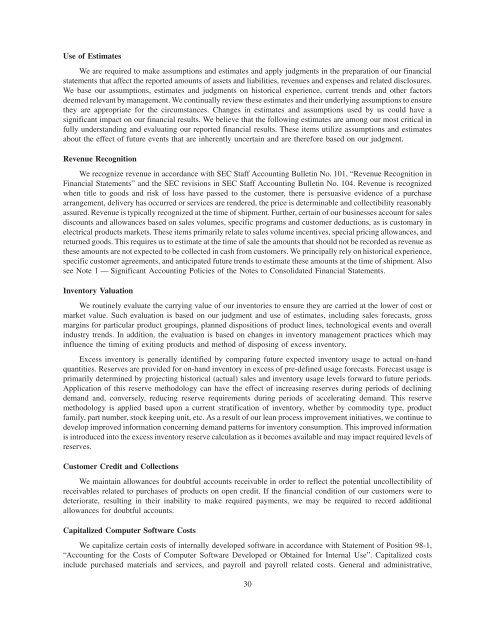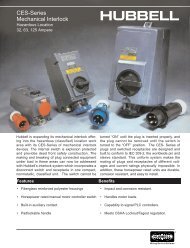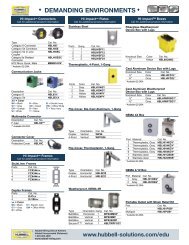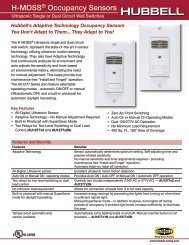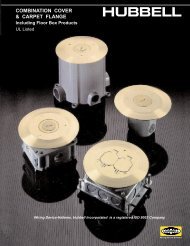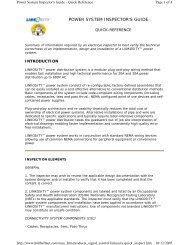2008 Annual Report - Hubbell Wiring Device-Kellems
2008 Annual Report - Hubbell Wiring Device-Kellems
2008 Annual Report - Hubbell Wiring Device-Kellems
- No tags were found...
You also want an ePaper? Increase the reach of your titles
YUMPU automatically turns print PDFs into web optimized ePapers that Google loves.
Use of EstimatesWe are required to make assumptions and estimates and apply judgments in the preparation of our financialstatements that affect the reported amounts of assets and liabilities, revenues and expenses and related disclosures.We base our assumptions, estimates and judgments on historical experience, current trends and other factorsdeemed relevant by management. We continually review these estimates and their underlying assumptions to ensurethey are appropriate for the circumstances. Changes in estimates and assumptions used by us could have asignificant impact on our financial results. We believe that the following estimates are among our most critical infully understanding and evaluating our reported financial results. These items utilize assumptions and estimatesabout the effect of future events that are inherently uncertain and are therefore based on our judgment.Revenue RecognitionWe recognize revenue in accordance with SEC Staff Accounting Bulletin No. 101, “Revenue Recognition inFinancial Statements” and the SEC revisions in SEC Staff Accounting Bulletin No. 104. Revenue is recognizedwhen title to goods and risk of loss have passed to the customer, there is persuasive evidence of a purchasearrangement, delivery has occurred or services are rendered, the price is determinable and collectibility reasonablyassured. Revenue is typically recognized at the time of shipment. Further, certain of our businesses account for salesdiscounts and allowances based on sales volumes, specific programs and customer deductions, as is customary inelectrical products markets. These items primarily relate to sales volume incentives, special pricing allowances, andreturned goods. This requires us to estimate at the time of sale the amounts that should not be recorded as revenue asthese amounts are not expected to be collected in cash from customers. We principally rely on historical experience,specific customer agreements, and anticipated future trends to estimate these amounts at the time of shipment. Alsosee Note 1 — Significant Accounting Policies of the Notes to Consolidated Financial Statements.Inventory ValuationWe routinely evaluate the carrying value of our inventories to ensure they are carried at the lower of cost ormarket value. Such evaluation is based on our judgment and use of estimates, including sales forecasts, grossmargins for particular product groupings, planned dispositions of product lines, technological events and overallindustry trends. In addition, the evaluation is based on changes in inventory management practices which mayinfluence the timing of exiting products and method of disposing of excess inventory.Excess inventory is generally identified by comparing future expected inventory usage to actual on-handquantities. Reserves are provided for on-hand inventory in excess of pre-defined usage forecasts. Forecast usage isprimarily determined by projecting historical (actual) sales and inventory usage levels forward to future periods.Application of this reserve methodology can have the effect of increasing reserves during periods of decliningdemand and, conversely, reducing reserve requirements during periods of accelerating demand. This reservemethodology is applied based upon a current stratification of inventory, whether by commodity type, productfamily, part number, stock keeping unit, etc. As a result of our lean process improvement initiatives, we continue todevelop improved information concerning demand patterns for inventory consumption. This improved informationis introduced into the excess inventory reserve calculation as it becomes available and may impact required levels ofreserves.Customer Credit and CollectionsWe maintain allowances for doubtful accounts receivable in order to reflect the potential uncollectibility ofreceivables related to purchases of products on open credit. If the financial condition of our customers were todeteriorate, resulting in their inability to make required payments, we may be required to record additionalallowances for doubtful accounts.Capitalized Computer Software CostsWe capitalize certain costs of internally developed software in accordance with Statement of Position 98-1,“Accounting for the Costs of Computer Software Developed or Obtained for Internal Use”. Capitalized costsinclude purchased materials and services, and payroll and payroll related costs. General and administrative,30


